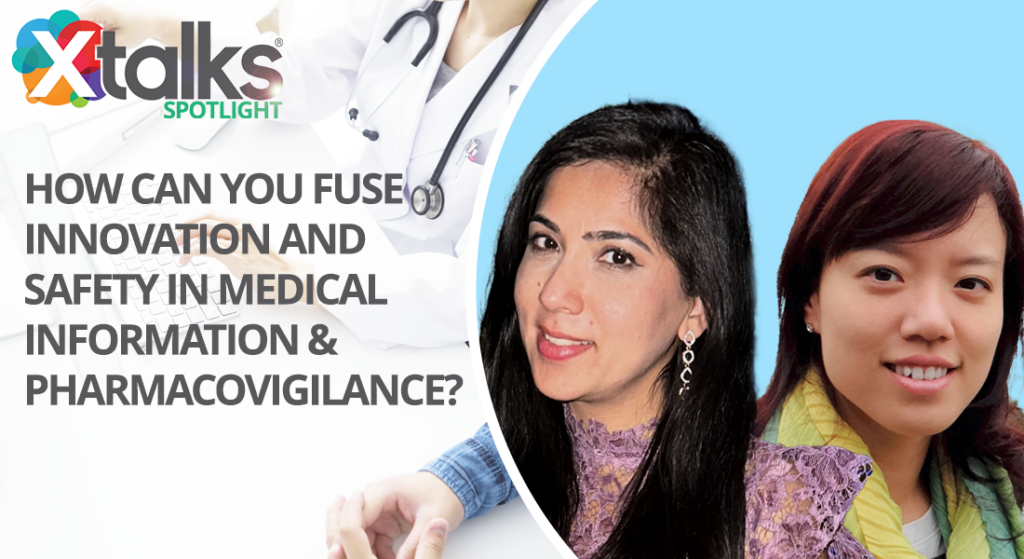The intersection of patient safety, technology and innovation in the pharmaceutical industry has given rise to substantial changes in medical information and pharmacovigilance. This dynamic landscape is marked by the integration of patient-centric approaches, real-world evidence and cutting-edge technologies.
Pharmaceutical companies are navigating the challenges and opportunities presented by AI-driven analytics, wearable devices and patient-generated data, redefining how adverse events are detected, reported and managed. Striking a balance between harnessing the power of digital ecosystems and ensuring regulatory compliance remains a central concern.
In this Xtalks Spotlight feature, Xtalks spoke with two industry experts from ProPharma, Valerie Huh, Associate Director of Global Innovation and Implementation for Medical Information and Patient Support Contact Centers; and Priyanka Dhingra, Senior Pharmacovigilance Manager, Regulatory Intelligence and Submissions.
Huh and Dhingra shared their insights on the quick implementation of data analytics and AI in medical information and pharmacovigilance.

Associate Director of Global
Innovation and Implementation
for Medical Information,
ProPharma

Senior Pharmacovigilance
Manager, Regulatory
Intelligence and Submissions,
ProPharma
“Medical information serves as a contact center dedicated to disseminating scientific knowledge to the public. The impact of AI, machine learning and natural language processing (NLP) on our field is profound,” Huh says.
Huh is a versatile scientist and pharmacist with 20 years of experience in pharmaceuticals, pharmacy and contract research organizations (CROs). She is committed to improving healthcare outcomes through innovative communication strategies.
Dhingra is a pharmaceutical professional with over 15 years of experience in various fields including pharmacovigilance for drugs, biologics, medical devices and vaccine safety.
Dhingra also has experience in regulatory intelligence, medical information, pharmacy benefit management, quality management systems, training, compliance, clinical and retail pharmacy.
“Recent advances in medical informatics and AI can allow more efficient ways to collect, process and analyze large amounts of safety data for drug companies and regulatory authorities across the world,” says Dhingra. Her insights reflect Huh’s, showing a shared vision of using technology to safeguard patient health.
The Challenges of AI Use
Since AI is being increasingly used to analyze large datasets, there are concerns with data privacy and security. Huh warns that AI can make it challenging to handle sensitive data like healthcare information responsibly and securely. This places a big responsibility on developers and businesses to ensure the proper use of sensitive data to protect the privacy of individuals.
“AI technology is rapidly advancing and widely populating without standardized industrial guidelines,” explains Huh.
Despite these difficulties, Huh is optimistic. She believes researchers, policymakers, industry leaders and communities can come together to solve each challenge that comes along from using AI.
Balancing Data Collection with Patient Privacy
The field of medical information is trying to apply innovative approaches to data collection without compromising patient privacy.
Huh emphasized that patient privacy is an essential priority at ProPharma. “We only collect a minimal amount of information we need to fulfill our services and meet regulatory requirements,” she stated, noting their commitment to transparency and the right of patients to grant or revoke permissions for the use of their data.
ProPharma’s strict data privacy policies and security measures aim to preserve patient privacy. The company has extended its communication routes with patients from the traditional call center to multi-channel and omni-channel models. This has been reinforced with encryption, data loss prevention product protocols and access control mechanisms like user privilege and multi-factor authentications.
In addition, the company takes a proactive approach by conducting regular audits and updating security measures to keep up with the latest technologies and regulatory changes.
Cross-Industry Partnerships to Improve Medical Information
A medical information team provides clinical and scientific information about medical products to the general public, patients and healthcare providers.
According to Huh, ProPharma has a team of over 700 medical information specialists. Their team uses multilingual capabilities and healthcare backgrounds to effectively communicate complex data to their customer base. In addition, the company’s medical information division serves over 200 pharmaceutical and biotech clients.
Huh says Pro Pharma’s collaborations with specialized partners in telephony, database management and software vendors have been central in advancing their medical information services. Beyond handling phone calls and emails, these partnerships have allowed for the creation of various communication avenues to engage their customers. This shows the importance of collaboration to deliver accurate and complete medical information.
AI and Harmonizing Safety Information from Across the World
AI can help improve pharmacovigilance processes throughout organizations, countries and regions. However, the use of AI for pharmacovigilance activities is not without challenges.
Firstly, different countries have different reporting and safety requirements, so using AI to analyze data from different parts of the world could be challenging.
Dhingra points out that processing large amounts of data from across regions can also be very costly and may yield results with low accuracy. In addition, the amount of data accessible from different regions may be limited or the data may be of low quality. This can affect the accuracy and reliability of the results; therefore, some data collection standards would have to be set.
“Data bias across different regions and lack of diverse data is another limitation that we face, especially from regions of the world where data may be misrepresented,” added Dhingra. She also raised ethical concerns about handling sensitive personal information, stressing the need for caution to prevent misuse.
Even with these challenges, Dhingra believes in the potential of AI to accelerate the availability of safe and effective treatments globally. However, she says that more research is needed to fully understand AI’s impact on harmonizing pharmacovigilance activities across the world.
The Future of Pharmacovigilance and Medical Information Management
Pharmacovigilance and medical information management are set to change due to advancements in AI, machine learning and NLP.
Dhingra outlined several ways that AI could assist pharmacovigilance processes:
- AI can streamline the collection and analysis of large safety data sets, which is traditionally a labor-intensive process.
- AI can collect timely safety data from online social discussion forums to detect adverse drug reactions and safety signals.
- Using AI for literature searches can assist human experts in the detection of valid individual case safety reports (ICSRs).
- Automating the coding of adverse event reports can improve drug safety science.
- With the use of algorithms, automatic processes and automated surveillance, AI could play a vital role in clinical trials by predicting and monitoring adverse events, providing real-time alerts and surveillance.
However, Dhingra cautioned that because pharmacovigilance deals with sensitive data and patient safety, more studies need to be done to validate the use of AI.
According to Huh, AI’s role in medical information management includes the integration of speech-to-text, AI voice generation, AI translation, workforce management and other technologies. These tools, she believes, are just the beginning of reducing administrative burdens and providing quick access to information.
Huh suggested several ways that AI could improve medical information management:
- AI-powered search and retrieval can quickly provide customers with accurate medical information from large databases.
- AI-powered analytics can quickly uncover trends and other insights much faster than the manual collection, categorization and analysis of data.
- AI technology can be applied to quality control for instant feedback and correction.
- AI-driven chatbots and virtual assistance can provide healthcare providers, patients and the public with relevant medical information with 24/7 availability.
Like Dhingra, Huh stressed the importance of validation studies and the need to uphold data privacy, security and ethical considerations when integrating AI into medical information processes.
Gain more insights into the opportunities of AI in pharmacovigilance and medical information management by watching this Xtalks Spotlight discussion.
This article was created in collaboration with the sponsoring company and the Xtalks editorial team.





Join or login to leave a comment
JOIN LOGIN